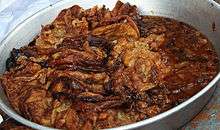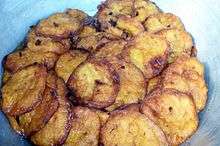Malpua
 | |
| Alternative names | Amalu |
|---|---|
| Course | Dessert |
| Place of origin | Indian subcontinent |
| Region or state | Odisha, West Bengal, Assam, Rajasthan, Uttar Pradesh, Bihar, Maharashtra in India |
| Associated national cuisine | India, Bangladesh, Pakistan |
| Main ingredients | Plain flour, rice flour, sugar |

Malpua is a pancake served as a dessert or a snack originating from the Indian subcontinent, popular in India, Nepal and Bangladesh.[1] It is a very popular dish of Odisha. Apart from other dishes like Pheni, Rabidi, Kheera sara and other cheese or chhena based items malpua is one of the most popular buyouts in the streets of Puri in Odisha. Malpuas are also prepared in Odia homes during Raja sankranti.
Malapua and its varieties
The batter for malpua in some areas is prepared by crushing ripe bananas or (in Bangladesh) coconut, adding flour, and water or milk. The mixture is sometimes delicately seasoned with cardamoms. It is deep fried in oil, and served hot. In Odisha the Malpua fritters are dipped in syrup after they are fried. The Bihari version of this dish has sugar added to the batter prior to frying.
Malpua is popular in Bangladesh, Odisha, West Bengal and Maharashtra and Nepal where it is served during festivals along with other sweets. Amalu (Malpua) is one of the Chapana Bhoga of Lord Jagannath and is included in the Sanja Dhupa (evening prayer). Other variations of Malpua use pineapples or mangoes instead of bananas. Bengali, Maithili and Odia malpua is traditionally made only with thickened milk and a little flour (sometimes rice flour instead of wheat flour).
Malpua in northern India, particularly in Uttar Pradesh, Bihar and Rajasthan, don't contain fruit. There are several variations, using some or all of the following ingredients: maida (refined flour), semolina, milk, and yogurt. The batter is left to stand for a few hours before being spooned into a kadhai of hot oil to form a bubbling pancake which should be crisp around the edges. The pancakes are then immersed in a thick sugar syrup. Malpua is a popular sweet to make on the Hindu religious occasion of Holi. Malpua along with mutton curry is served in many non-vegetarian Maithil homes during Holi.[2]
Malapua in Nepal also known as Marpa is specially made in the Kathmandu Valley which uses maida, mashed up ripe bananas, fennel seeds, pepper corns, milk and sugar into a batter and prepared in a similar way as in India.
Malpua is a famous dish during the Muslim holy month of Ramadan. Muslim families across India, as well as Pakistan prepare malpuas for iftar (meal to break the fast). This malpua includes maida, rawa, and khoya/ mawa (milk solids), and is deep fried to take the shape of a pancake. In some recipes, malpuas are dipped in sugar syrup called sira before serving. They are famous in Odia cuisine
History
Barley was the most prolific grain eaten by the arya of the Vedic period. One preparation was a sweet cake called apūpa, where barley flour was either fried in ghee or boiled in water, and then dipped in honey. Malpua preserves both the name and the essentials of this preparation.[3]
Odia malapua recipe
Amalu is a generic term used for the Sanja dhupa of Jagannath temple and several types of Amalu (Bada Amalu, Sana Amalu) are offered to the lords as the Sanja Dhupa(evening dhupa).
Ingredients
For Amalu
- 250 ml of Yogurt
- 3 tbsp of refined Flour
- 3-4 tbsp of Ghee/oil for frying
- 1 tsp of Roasted fennel seeds
For Sugar Syrup (Sira/Raseni)
- 200 gm of Sugar
- Rind of 1 sweet lime
- 200 ml of Water
Preparation
Combine yogurt, flour and fennel seeds. Stir until a smooth batter is formed. Heat ghee/oil in a pan and make dumplings by frying a spoonful of the batter at a time over a gentle flame. Remove from the pan and drain. Prepare the syrup with sugar, water and rind. Dip the Malpuas into the syrup. At home it can be garnished with sweet lime segments and cream. It can be decorated with silver leaf. It is served hot/cold.
Bengali malapua recipe
This variety is a recipe of fried malapua. There are also versions in which it is soaked in sugar syrup then served.
Ingredients
- 2.5 cups plain flour
- 0.5 cup rice flour
- 2.0 cups sugar
- 3.0 cups water
- 1.0 cup shredded coconut
Preparation
Mix the ingredients to make a moderately thick batter. Sugar can be added if more sweetness is desired. If making a larger quantity always have five times as much plain flour as rice flour to keep the batter together. Pour a quarter cup of batter and pour into a pan with oil. Several pancakes may be cooked at any given time, but each piece must be submerged under the oil in order to cook properly. Cook for about ten minutes and then let it cool for two minutes for an ideal flavor.
Ingredients
- 600 ml ghee
- Cardamom 50 g
- Fennel seed 20 g
- Semolina 500 g
Heat ghee in a deep kadhai (wok). Mix semolina with water to make a thick batter. Mix cardamom, fennel seeds and 10 g of sugar. Fry the batter in hot ghee and dip in sugar syrup.
See also
- Gulgula – a related sweet that is often round
References
- ↑ Ray, Dipti (2007). Pratapararudradeva: The Great Suryavamsi King Of Orissa 1497 To 1540. Lecture Notes in Mathematics 1358. Northern Book Centre. ISBN 978-8172111953.
- ↑ http://www.ifood.tv/network/Malapua
- ↑ Achaya, K.T. (1998). Indian Food: A Historical Companion. Oxford University Press. p. 33. ISBN 978-0195644166.